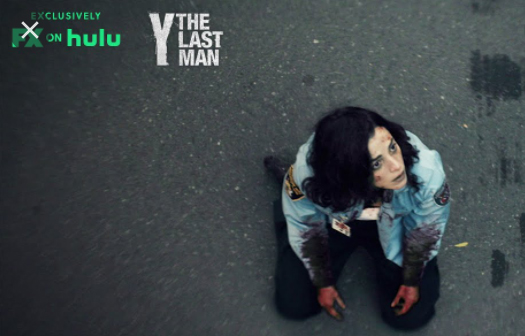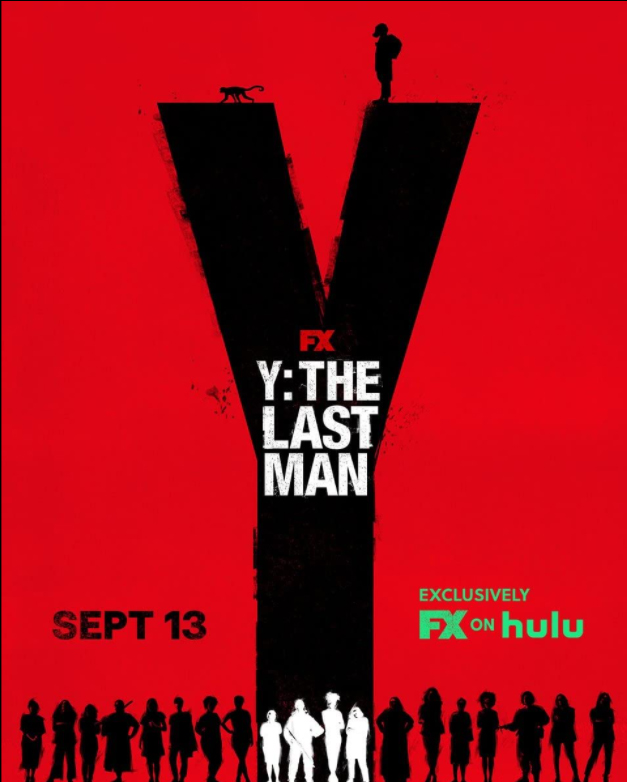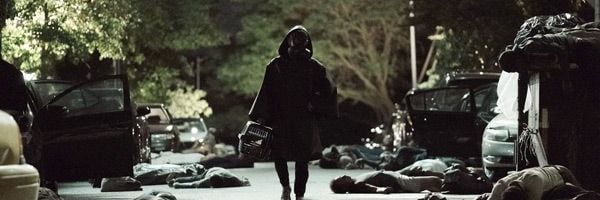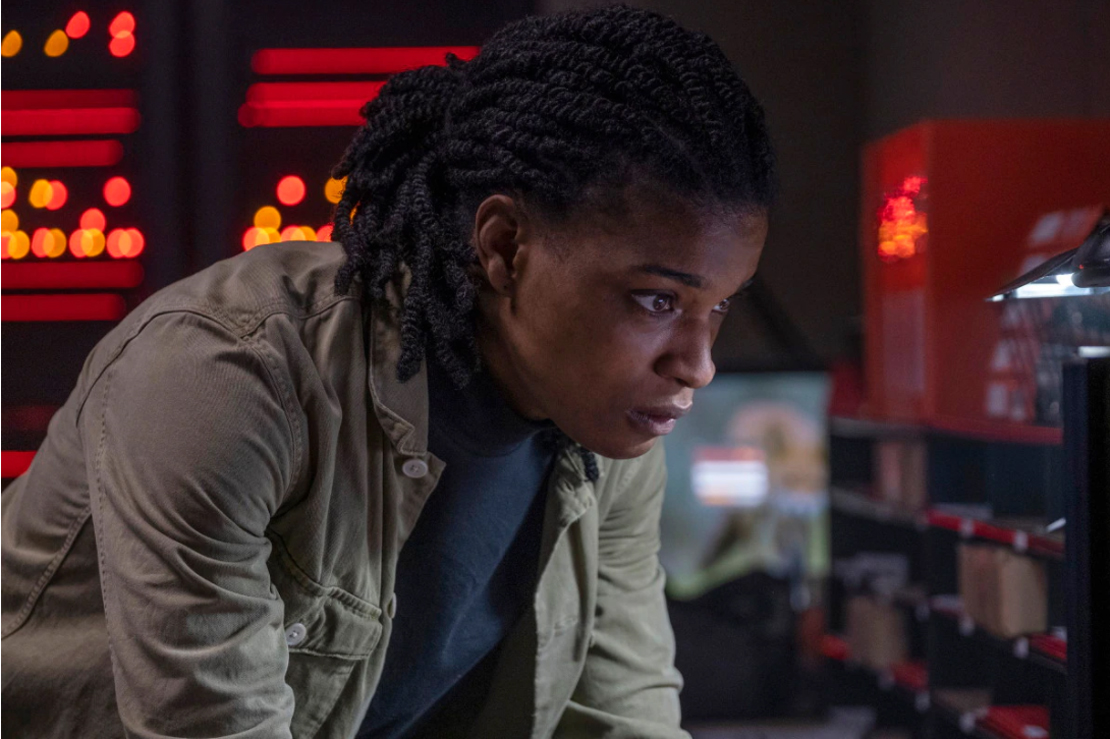September 14, 2021
Interview: Herdís Stefánsdóttir – Scoring FX’s Y: THE LAST MAN
by Randall D. Larson
Imagine going about your day when suddenly every person on the planet with a Y chromosome mysteriously DIES… except one. That’s the premise of FX’s new series Y: THE LAST MAN, which premiered on Hulu on September 13. Based on the critically acclaimed graphic novel series by Brian K. Vaughan, the FX series stars Diane Lane, Ashley Romans, Ben Schnetzer, Olivia Thirlby, and Amber Tamblyn. It is scored by Icelandic composer Herdís Stefánsdóttir, who took an unconventional approach to create an experimental, apocalyptic, adventurous, and hopeful score.
Herdís Stefánsdóttir is a composer of music for multimedia, a songwriter, and an electronic musician. Her compositional endeavors — installations in museums, dance, theatre, and a successful electro-pop music duo she is a part of (East of My Youth) – are establishing her as an expansive artist. Her scoring work includes Ry Russo-Young’s MGM/Warner Bros. feature film, THE SUN IS ALSO A STAR (Herdís was nominated for The Icelandic Music Awards for her score) and the HBO series WE’RE HERE. Herdís interned for the Oscar nominated composer Jóhann Jóhannsson in Berlin while he was working on the film ARRIVAL (2016) and she has scored numerous short films that have premiered at top-tier festivals.
The first piece of music she wrote was a requiem for the lost men. Herdís imagined a collective cry of every female voice in the world, screaming at each other in confusion, lamenting the loss of their loved ones, and the chaotic sounds of this uncertain new world. Herdís channeled all of that grief and loss into her music for the series as a response to tragedies happening in our own world the past couple years… a theme that was shortened and became the main titles for the series.
Watch the opening scene from Y: THE LAST MAN via FX Networks, with Herdis Stefánsdóttir’s “Requiem” theme.
Q: How did your musical background prepare you for scoring in films, and what initially brought you into film scoring?
Herdís Stefánsdóttir: I didn’t have a typical background. I played piano when I was eight for a few years and stopped that. And then I was not really on the track of becoming a musician; I was just doing other things and studying at University. It wasn’t until my early 20s that I got the idea that I could write music. I applied for a Bachelor in Classical Composition, and following that I did a Masters of Music too. Then I did a Masters in composition with emphasis on films and film scoring at NYU in New York, and my school was right next to NYU Tisch, where there were a lot of young directors experimenting. I was living in New York for a couple of years and I got to know a lot of people, and I was doing short films and I started to do commercials and things. Those were my first experiences with doing films. Then I was also working on my own music and it wasn’t until a couple of years after I graduated that I got my first film call to score a feature film.
Q: How did you become involved with Y: THE LAST MAN?
Herdís Stefánsdóttir: I have an agent who tells me about projects that might be interesting for me, and when she emailed me about Y: THE LAST MAN I was very intrigued. I hadn’t read the graphic novel but just learning about the story sounded really cool and interesting to me. I hadn’t done anything in this kind of space before, an apocalyptic TV series, so I didn’t really have a library or a catalog of music to put forward, but I just tried with my best instinct to find material that I had that could fit, which I sent to the people at the show. They liked it and we had a conversation and I got hired on the show, which was unexpected!
Q: What were your early discussions with the filmmakers about the type of music they wanted for this series?
Herdís Stefánsdóttir: They hadn’t decided what kind of music they were looking for. Initially they were just interested in what ideas I had about the sound for Y: THE LAST MAN. So the first conversation was when they were very much in the beginning stages of being open to that kind of music, and what was cool was that I really had space to dig in on my own and explore it without anyone telling me exactly what to do.
Q: Would you describe your sonic palette for the series and what inspired it?
Herdís Stefánsdóttir: My initial idea came when I was starting to come up with a sound for the show and the first theme. I read the graphic novel and a few of the episode scripts, although not all of them, and I’d seen the first couple of episodes. In the beginning of the show we’re thrown straight into the event of the apocalypse, which is only the beginning of the story and not really what the show is about – but it’s when it happens that every living being with a Y chromosome just drops dead, so it’s a really chaotic, intense event, and my first idea for the sound, or the emotion of that happening, was this clutter of female voices screaming and shouting at each other, some times in dissonance and sometimes in harmony. My initial idea was to shape the score based around the female voice, and that’s what I did. I recorded a female choir doing a lot of weird things, and they were great. I built and sampled and processed that to be the foundation of the sonic world of the score.
Q: The premise of the series, at the start, is one of tremendous loss and tragedy. How did you conceive your requiem for the lost men, and how did it develop across the arc of the series thus far?
Herdís Stefánsdóttir: While I was writing the requiem I wanted to capture this scream of despair and in a way pay a tribute to all the fallen people who had died, and build a beautiful theme which represents the collapse of the old world. But that theme throughout the season is following what is happening, from the fallen old world, and there is a new world being born where the surviving people have to find their identity and find a way to kind of be born again, under these extremely weird circumstances.
Q: Your main title music is very striking – how did this cue come about and was given its own sonic dynamic?
Herdís Stefánsdóttir: The main title comes from the new world, which is a completely lawless world. It’s a world that is chaotic and doesn’t have rules, but it’s also a world that has hope and there’s something new and possibly very exciting and different being built on that, so it drew inspiration from the wild West when composing that. That also represented the personal journey of the main characters and their journey through this new world.
Q: Your wild West music is quite striking – what can you tell me about the development of that music and what it represents?
Herdís Stefánsdóttir: That was me exploring and going for just being an Icelandic woman from the north drawing inspiration from the musical tradition of the West, like Ennio Morricone built music for the cinema about the West, but also about American folk music – a lot of traditions from the story are folk music and I tried to take influence from that while doing something that felt special and felt different from that film sound.
Q: How have you found scoring for the longer treatment of a series versus composing music for a standard-length feature film or short?
Herdís Stefánsdóttir: It was a very different experience, partly because I wrote the score very differently from my previous work, because I didn’t write it to picture. I wrote the entire score completely after reading the script, before seeing the film. In my experience, having done a couple of features and a few shorts before, this project felt very bigger and more expansive, so the possibility of building a few different worlds within the series was very exciting. Those worlds and their different characters have their own stories. There’s a lot of storytelling and a lot of worldbuilding when scoring a big fictional adventure like this.
Q: As you mentioned earlier, choir and individual voices are a very compelling ingredient of your score here. Would you describe your use of voices and how they were recorded and used in the score?
Herdís Stefánsdóttir: I recorded the choir in a small town in the north of Iceland. I started with recording ten women, and that was in the absolute beginning process of writing the score, so I’d only written the requiem and a few musical ideas. I didn’t really have a lot to build on. But I really like working with audio and having the options of sampling it and pitch shifting and all that. So I wrote out sheet music where I would come up with ideas, I’d write something like alien speech or like shouting at each other or talking in a clutter, using specific notes. I experimented with them and then as I kept on writing the score I used a lot of my own voice for writing melodies, and I mainly recorded that myself in my own studio.
Q: In addition to the score, did you use an orchestra or ensemble for the other music or was that coming out of your studio?
Herdís Stefánsdóttir: A lot was coming out of my studio. The score is partly modular synthesizer-based but I did record a string orchestra, especially for the Western music. A good friend of mine recorded a lot of guitars for the lawless world and the Western part of the score, and I had a drummer friend record percussion. So I did recordings here and there, but a lot of it came out of my own studio.
Q: The intensity of the violin in Yorick’s theme is quite appealing – how did this track come about, and how is it used in the show?
Herdís Stefánsdóttir: This track was purely inspired by Yorick [the “last man”] and his character. He’s like a privileged kid in his 20s, he’s a little naïve, a little bit of a doofus, but still a really likable character. What struck me as interesting about Yorick is that I felt his main drive, at least in the script, was his desire for his ex-girlfriend Beth who bailed on him. I felt that through the apocalypse and all the gnarly things that are happening in a world that is falling apart, Yorick is going on his journey a little bit with rose-colored glasses, imagining Beth is always at the end of the horizon. So Yorick’s theme became a love theme.
Q: Once you had your cues that you wrote apart from picture, what was your process of then putting them into sync with the episode scenes?
Herdís Stefánsdóttir: I was working with a very amazing music editor named Suzana Peric, very experienced and extremely good at what she does. She had all the music that I had written and placed the music in the show in conversation with me. She did a lot of things that I thought were very inspiring and I learned a lot from it. Sometimes she would take something that I had written or had an intention for and place it somewhere that I would never have thought of, and I thought that created something really interesting between the two of us in this collaboration.
Q: What was most challenging about scoring Y: THE LAST MAN – and what was most rewarding for you?
Herdís Stefánsdóttir: I would say that my biggest obstacle came at the beginning of the project. Like composers do, I would pull up the picture and purely started writing. The music supervisor, Susan Jacobs, told me “you’ve got to find the sound of the show, you’ve got to create the world and tell us the story.” So that’s when I put the picture away and went through all the scripts and the graphic novel and really dove in and started understanding the story and doing my own version of the story by creating the themes without being stuck to the picture. In that sense, I could also write themes that were many minutes long and they would develop and have chapters and I felt that I could in some sense go deeper into creating the worlds and the themes, instead of being glued to scenes that are forty seconds or a minute long, where you’re cut off in the middle of the creative process. I think that was also one of the most rewarding parts, being able to write the music like this, just freely, without the picture and also the collaboration with the music editor.
Thanks to Herdís Stefánsdóttir for taking the time out to discuss this score with me, and to Andrew Krop and Kyrie Hood of White Bear PR for facilitating this interview. Photos copyright Disney/FX Networks.
For more information on the composer, see her website at https://www.herdisstefansdottir.com/
Watch the series trailer for Y: THE LAST MAN:













